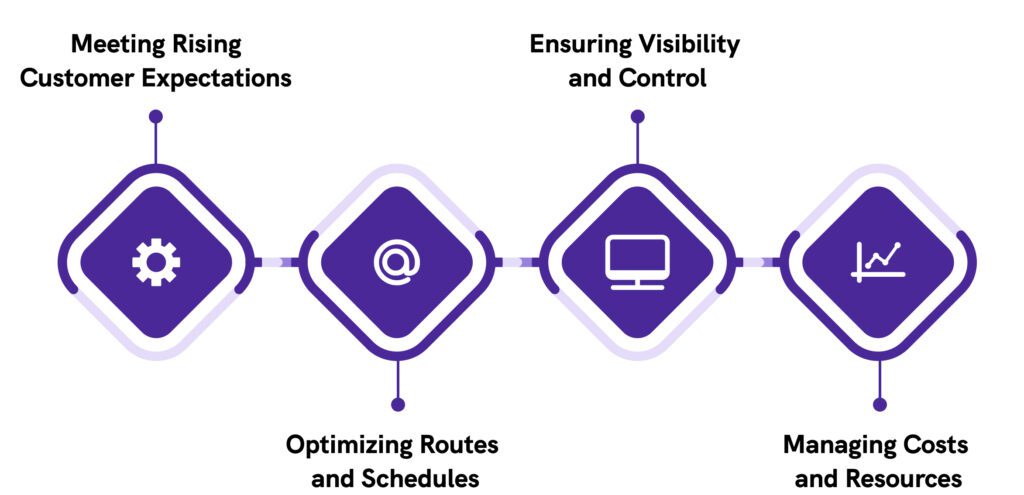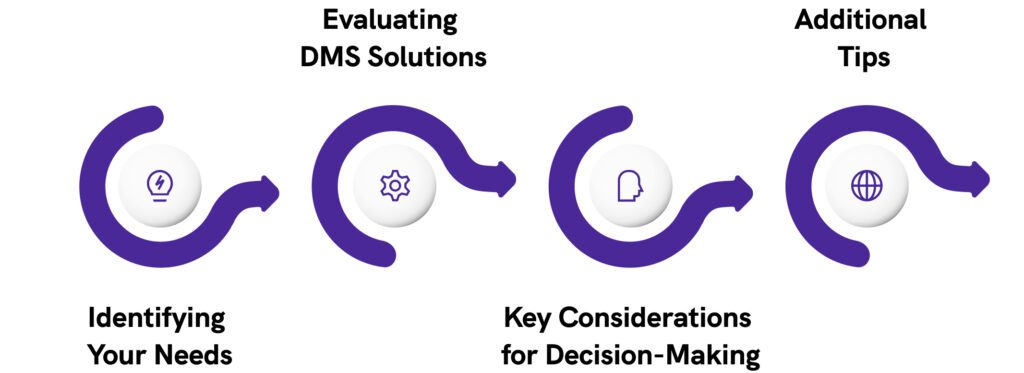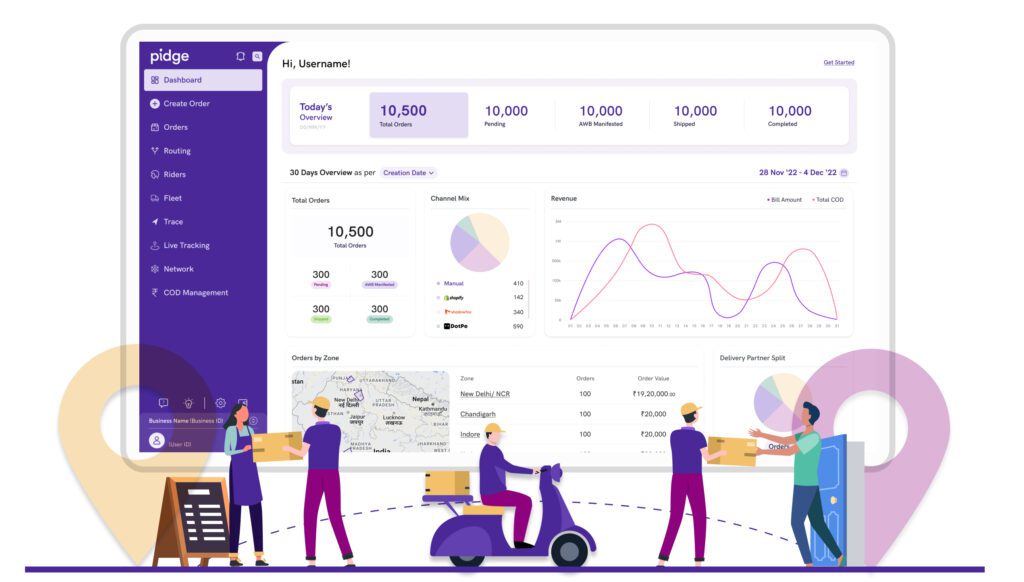As the delivery demands rise across the entire globe, delivery businesses are no longer competing across the delivery SLAs, like time, delivery windows, etc. Also, as per The World Economic Forum report, urban last-mile delivery demand is forecasted to surge by 78% by 2030. Hence, businesses are in for a grueling and highly competitive journey to delight the customers, save costs, stay sustainable, and unlock growth. All these factors are driving the need and rapid adoption of delivery management software.
Delivery management software streamlines logistics operations by optimizing routes, tracking deliveries in real-time, and automating processes. It enhances efficiency by reducing delivery times, minimizing fuel costs, and improving customer satisfaction with accurate ETAs.
The global Last-Mile Delivery Software Market is growing at a CAGR of 8.1% and is expected to hit the USD 16.7 Billion mark by the end of 2032. Further, Statista projects that the platform delivery market worldwide is poised for significant revenue growth, reaching a staggering figure of US$282.60 bn by 2024.
Delivery management solution is a comprehensive software solution designed to streamline and optimize the entire delivery process, from order placement to final delivery and customer feedback. It acts as a central hub, integrating various functionalities to empower businesses to manage their delivery operations with greater control, efficiency, and transparency.
Here, we take a deep dive into the various benefits of delivery management software in detail, cover the different challenges businesses encounter in delivery operations management and orchestration, and identify how opting for the right software can help them overcome these challenges. We also share some of the key considerations that every business should keep in mind while investing in a delivery management software solution.
What is Delivery Management Software (DMS)?
Delivery management software solutions help businesses unlock increased productivity, reduced operational expenses, and enhanced visibility into their delivery networks. Additionally, features like route optimization, automated scheduling, and analytics empower businesses to make data-driven decisions, improving overall performance and competitiveness in the market.
Here are some of the core functionalities offered by a delivery management system:
Route Optimization: Utilizing intelligent algorithms and real-time data like traffic conditions, weather patterns, and historical delivery information, delivery management software helps plan and optimize delivery routes for efficiency. This minimizes delivery times, reduces fuel consumption, and ultimately saves businesses money.
Real-time Tracking: It provides real-time visibility into the location and status of deliveries. This allows businesses to monitor driver progress, track packages throughout their journey, and ensure timely deliveries. Moreover, it allows for proactive communication with customers, updating them on the estimated time of arrival (ETA) and addressing any potential concerns.
Process Automation: DMS automates manual tasks associated with delivery management, such as order processing, driver assignment, route planning, and invoicing. This reduces errors, saves time and resources, and allows businesses to focus on other critical aspects of their operations.
Performance Reporting and Analytics: It provides insightful reports and analytics that enable businesses to track delivery KPIs, identify areas for improvement, and make data-driven decisions. This allows them to optimize their delivery operations for continued efficiency and cost-effectiveness.
By integrating these functionalities, DMS empowers businesses to:
Enhance efficiency: Reduce delivery times, minimize fuel costs, and streamline operations.
Improve customer satisfaction: Provide real-time updates, transparent communication, and accurate ETAs.
Increase productivity: Automate workflows and optimize resource allocation.
Reduce costs: Minimize errors, optimize fuel consumption, and better utilize resources.
Challenges Faced in Delivery Operations Management

Meeting Rising Customer Expectations: Customers today expect a seamless delivery experience, demanding faster deliveries at lower costs, with complete transparency throughout the process. This puts immense pressure on businesses to continually improve their delivery times.
However, achieving faster deliveries often necessitates optimizing routes and schedules, which can lead to increased costs. Balancing these factors while also providing real-time delivery updates and clear communication throughout the journey is a significant challenge for businesses.
Optimizing Routes and Schedules: Finding efficient delivery routes that minimize travel time and fuel consumption can be a complex task, especially in large geographical areas with heavy traffic congestion. Additionally, adhering to complex schedules with multiple stops, tight deadlines, and unforeseen delays further complicates the process.
Manually planning and optimizing routes for each delivery can be time-consuming and error-prone, often leading to inefficiencies and dissatisfied customers.
Ensuring Visibility and Control: Maintaining real-time visibility into the location and status of deliveries is critical for ensuring on-time deliveries and providing excellent customer service. However, this can be difficult due to factors like a large number of deliveries spread across a wide geographical area, multiple drivers with varying routes, and diverse delivery methods (e.g., vans, bikes).
Without real-time visibility, it’s challenging to track progress, address potential delays, and proactively communicate with customers.
Managing Costs and Resources: Optimizing fuel consumption, minimizing operational expenses, and effectively utilizing resources like vehicles and drivers are crucial for businesses to maintain profitability. However, this requires careful planning, route optimization, and efficient resource allocation.
Fluctuating fuel prices, inefficient routes with unnecessary travel time, and improper driver scheduling can significantly impact operational costs. Additionally, under-utilizing resources or assigning the wrong vehicle type to a delivery can negatively impact efficiency and customer satisfaction.
These challenges highlight the need for effective solutions that can help businesses streamline their delivery operations, improve efficiency, and meet the evolving demands of the market. This is where delivery management software plays a crucial role by providing powerful tools and functionalities to address these challenges and empower businesses to achieve their delivery goals.
How Delivery Management Software Overcomes Management and Orchestration Challenges?
Route Optimization: A delivery management system leverages the power of Artificial Intelligence (AI) and data analytics to optimize delivery routes in real-time, considering factors like traffic conditions, weather patterns, historical delivery data, and driver availability. This intelligent approach minimizes travel time and fuel consumption, leading to faster deliveries, reduced costs, and a smaller environmental footprint.
Automated Scheduling and Dispatch: Delivery management software solution streamlines the scheduling and dispatch process by automating tasks such as order assignment, driver scheduling, and route planning. This eliminates manual errors and frees up valuable time for businesses to focus on other critical aspects of their operations.
Additionally, features like dynamic dispatch allow businesses to adjust schedules and routes in real-time to address unexpected delays and optimize resource allocation.
Real-time Tracking and Visibility: Delivery management solutions provide real-time insights into the location and status of deliveries through features like GPS tracking and automated updates. This allows businesses to monitor driver progress, track package location throughout its journey, and anticipate potential delays.
This information empowers proactive communication, enabling businesses to update customers with accurate ETAs and address any concerns, ultimately leading to improved customer satisfaction.
Cost and Resource Optimization: Software for delivery management offers functionalities that help businesses control fuel costs, minimize errors, and optimize resource allocation. By analyzing historical data and driver performance, it can identify fuel-efficient routes and suggest alternative options based on real-time traffic conditions.
Additionally, automated scheduling and route planning help minimize unnecessary travel time and ensure proper vehicle utilization. By minimizing errors through automation and data-driven insights, it also helps businesses reduce operational costs and improve overall efficiency.
Improved Customer Communication: DMS fosters improved customer communication by facilitating two-way communication channels. Customers can track their deliveries in real-time and receive automated notifications with estimated arrival times and any potential delays.
Businesses can also proactively communicate with customers through the platform, addressing concerns and providing updates, resulting in a more transparent and positive customer experience.
Empowering Efficiency and Customer Satisfaction: The Core Benefits of Delivery Management System
- Enhanced Efficiency
Reduced Delivery Times: A delivery management platform optimizes routes, automates workflows, and provides real-time tracking, leading to faster deliveries and improved customer satisfaction.
Minimized Fuel Costs: By utilizing AI-powered route optimization and efficient scheduling, delivery management solution helps minimize unnecessary travel time and fuel consumption, resulting in significant cost savings.
Improved Customer Satisfaction: Accurate ETAs and real-time communication ensure a smoother delivery experience, leading to increased customer satisfaction and loyalty.
Boosted Productivity
Streamlined Workflows: Delivery management software solution automates repetitive tasks such as order processing, driver assignment, and route planning, freeing up valuable time for employees to focus on higher-level tasks.
Optimized Resource Allocation: By providing real-time insights into driver availability and vehicle utilization, software for delivery management enables efficient resource allocation, ensuring the right resources are at the right place at the right time.
Improved Decision-Making: Access to comprehensive data and performance reports empowers businesses to make data-driven decisions that further improve efficiency and resource utilization.
Increased Visibility
Real-time Tracking: It provides uninterrupted visibility into the location and status of deliveries, allowing businesses to monitor driver progress and track packages throughout their journey.
Performance Metrics: A DMS generates comprehensive reports and analytics that track key performance indicators (KPIs), enabling businesses to identify areas for improvement and optimize their delivery operations.
Proactive Problem-Solving: Real-time insights allow for proactive problem-solving, enabling businesses to address potential delays and ensure timely deliveries.
Reduced Costs
Lower Fuel Consumption: As mentioned earlier, Delivery management software optimizes routes and minimizes unnecessary travel, leading to significant reductions in fuel costs.
Minimized Manual Errors: Automation of repetitive tasks and data-driven insights help minimize human errors that can lead to costly mistakes and delays.
Optimized Resource Utilization: Efficient resource allocation ensures that vehicles and drivers are used effectively, reducing overall operational expenses.
Enhanced Customer Satisfaction
Improved Communication: Delivery management solution facilitates two-way communication between businesses and customers. Customers receive real-time updates and accurate ETAs, while businesses can proactively address concerns and provide transparency.
Transparency and Trust: Real-time tracking and clear communication foster transparency and build trust with customers, leading to a more positive and lasting customer relationship.
Reduced Wait Times: Accurate ETAs and proactive communication help manage customer expectations, minimizing wait times and improving overall customer satisfaction.
Choosing the right software solution for delivery management can be a game-changer for businesses operating in the demanding delivery landscape. With its ability to streamline operations, improve performance metrics, and ultimately deliver a superior customer experience, it is an essential tool for businesses looking to stay ahead of the curve.
Next, we share some of the key considerations for choosing the best delivery management solution for your business.
Selecting the Right Delivery Management Software: A Step-by-Step Guide


Identifying Your Needs
The first step is to conduct a thorough self-assessment to understand your specific needs and requirements. Consider factors like:
Business Size and Complexity: The scale of your operations, from a small local business to a large enterprise with complex delivery networks.
Delivery Volume: The average number of deliveries per day, week, or month.
Budget: The financial resources allocated for acquiring and implementing the delivery management solution.
Integration Needs: Compatibility with existing software systems like CRM or order management software.
By clearly defining these factors, you can narrow down the pool of potential DMS solutions and focus on options that cater to your specific business context.
Evaluating DMS Solutions
Once you have a shortlist of potential DMS solutions, delve deeper into their features and functionalities:
Core functionalities: Analyze if the solution offers essential features like route optimization, real-time tracking, automated scheduling, and performance reporting.
Additional functionalities: Explore advanced features like driverless delivery management, integration with delivery marketplaces, or proof-of-delivery options.
User-friendliness: Assess the ease of use for both administrators and drivers, ensuring a smooth learning curve and efficient adoption.
Customer Support: Evaluate the quality and accessibility of customer support offered by the vendor.
Security: Prioritize solutions with robust security measures to ensure data privacy and compliance with relevant regulations.
Key Considerations for Decision-Making
Beyond features, consider the following aspects when making your final decision:
Pricing Models: Compare pricing models such as subscription fees, per-user fees, or transaction-based pricing to choose the option that best fits your budget and usage patterns.
Vendor Reputation: Research the vendor’s track record, customer satisfaction ratings, and industry reputation to ensure a reliable and trustworthy partner.
Scalability: Choose a solution that can scale with your growing business needs, allowing for future expansion and increased delivery volume.
Potential Return on Investment (ROI): Calculate the projected cost savings, efficiency gains, and improved customer satisfaction to understand the potential return on your investment in DMS.
Additional Tips
To solidify your decision, consider these additional steps:
Explore free trials: Many software vendors offer free trials, allowing you to test the software and assess its functionality in your specific environment.
Read customer reviews: Gain valuable insights from real-world users by reading online customer reviews and testimonials.
Schedule demos: Request demos from shortlisted vendors to get a firsthand experience of the software and have your questions answered by product specialists.
Delivery Management – How can Pidge Help?


Here at Pidge, we understand the challenges and complexities of managing modern delivery operations. Equipped with a powerful Delivery Management System (DMS) and a commitment to hybrid interoperability, we offer a comprehensive solution to streamline your operations, enhance efficiency, and elevate your customer experience.
Pidge’s cutting-edge delivery management platform empowers you with:
AI-powered route optimization: Minimize travel time and fuel consumption, leading to faster deliveries and reduced costs.
Real-time tracking and visibility: Track drivers and packages in real-time, ensuring timely deliveries and proactive communication with customers.
Automated workflows: Automate repetitive tasks like order processing, driver assignment, and route planning, freeing up your team to focus on higher-level tasks.
Performance analytics and reporting: Gain valuable insights into your delivery operations, identify areas for improvement, and make data-driven decisions.
Enhanced communication: Facilitate uniform and centralized communication between businesses and customers, fostering transparency and trust.
Beyond our robust delivery management platform, Pidge sets itself apart with a focus on hybrid interoperability. We understand that businesses often use diverse software systems to manage their operations. Pidge seamlessly integrates with various platforms, including CRMs, order management systems, and accounting software, eliminating data silos and fostering a unified workflow.
Here’s what hybrid interoperability means for your business:
Reduced complexity: Eliminate the need for manual data entry between different systems, saving time and minimizing errors.
Improved data accuracy: Ensure consistent and accurate data across all your systems, leading to better decision-making.
Enhanced operational efficiency: Streamline workflows and optimize processes by seamlessly connecting your existing software ecosystem with Pidge’s delivery management platform.
Greater flexibility: Choose the integrations that best suit your specific needs, allowing for a customized solution that adapts to your evolving business landscape.
By combining powerful delivery management capabilities with hybrid interoperability, Pidge equips you with the tools and functionalities you need to:
Reduce costs: Minimize fuel consumption, optimize resource allocation, and streamline operations for overall cost savings.
Improve efficiency: Deliver faster, meet customer expectations, and optimize delivery performance.
Enhance customer satisfaction: Provide real-time communication, accurate ETAs, and a transparent delivery experience.
Gain a competitive edge: Stay ahead of the curve with innovative technology and a commitment to continuous improvement.
Ready to experience the Pidge difference? Contact us today to schedule a demo and discover how our delivery management software with hybrid interoperability can transform your delivery operations and elevate your business to new heights.

Leave a Reply